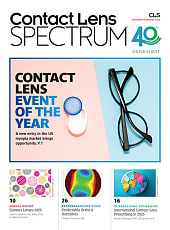Hands
On: ASK THE LABS
by Karlen Cole McLean, ABOC, NCLC
SHORT-TERM FIX
Q A patient recently asked about a liquid scratch repair for spectacle lenses. What is it? Does it work?
A Although I don't know which miracle liquid your patient saw, I can assure you that if these liquids worked long-term, many labs and retailers would be using them.
The key point is long term. You may be able to use this liquid temporarily, similar to wax used on furniture. When applied, it gives the appearance that scratches are gone.
However, it's only a temporary mask to an age-old problem: Once you denigrate the surface of the lens by scratching it, there is no effective bottled means to fix the problem.
-- Craig Giles, president, Soderberg Optical
BEATING THE BLUES
Q Our doctor recommends brown lenses to filter out damaging blue light to protect the macula from developing macular degeneration. My questions are:
1. To filter blue light, is there a specific brown color that works best?
2. Do gray polarized lenses--or any other color polarized lenses--filter blue light?
3. Do the lenses have to be a particular gradient level to effectively filter blue light?
A Blue light is generally taken to be that part of the spectrum between 400nm and 500nm.
To answer your questions:
1. Most brown colors will block blue light more than gray colors. The efficiency of blocking will depend on the actual hue of the brown color. Melanin color is thought to provide an optimum [blue light] blockage.
2. Gray polarized lenses filter all wavelengths equally (thus the "gray" color). Therefore, they reduce all wavelengths the same amount, and they let the same amount of blue color through the lens as other colors.
3. If the lenses block all of the blue light, there will be a color perception distortion by the wearer.
Thus, there are several approaches to block most of the blue light, while allowing enough to pass through the filter to maintain some color perception for the wearer. One option is a polarized Melanin lens.
-- Tom Moravec, PhD, director of technology, Vision-Ease Lens
Reaching Out
Q We are beginning to carry some unique frame styles, and sometimes the eyewire and temple screws are difficult to reach due to the frame design. What tools and techniques are there to reach screws that are nearly covered or otherwise inhibited?
A There are tools available for specific frame styles, such as drilled rimless, from major tool suppliers. I suggest reviewing their Websites or catalogs for availability. We also use medical forceps for difficult-to-reach screws; they can be purchased at any dental or medical supply store.
-- Dale Parmenteri, vice president, Balester Optical Company
If you have a question you'd like to have answered in Ask the Labs, send it to Karlen Cole McLean. Fax: 215-643-1705. E-mail: mcleank@boucher1.com. An archive of past Ask the Labs columns can be found on the Eyecare Business Website at www.eyecarebusiness.com.



